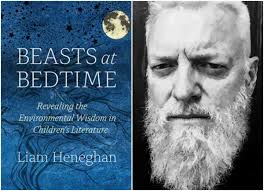Patricia Craig at the Dublin Review of Books:
 It’s a rare children’s book, Heneghan notes, that doesn’t have a wilderness interlude; but then he has to consider exactly what is meant by “wilderness”. It is doubtful if nature at its most extreme and untrammelled can exist in the world today, since even the wildest of wild places are shaped by the activities of people as well as natural forces. He cites as an example the Burren in Co Clare, along with the bogs and mountainy country of the west of Ireland ‑ all territories that have evolved over millennia as a consequence of human intervention in the landscape. However, if wilderness, or quasi-wilderness, occurs at one end of the environmental spectrum and the densely populated city at the other end, what occupies the space between them is denoted by the word “pastoral”, and this makes a highly fruitful ground for children’s stories. Section Two of Beasts at Bedtime considers the pastoral impulse in writing for children, with due attention paid to Pooh, Peter Rabbit, Rat and Mole, Bilbo Baggins, the Ugly Duckling and others. (But we miss Rupert, whose picture-strip adventures encompass many aspects of pastoral: woodland, meadowland, fields, hills, seaside, streams, lily ponds, cottage gardens … all the way to underground caverns and cannibal islands. And you’d have to say that Rupert, in one sense, goes one better than Winnie-the-Pooh. In AA Milne’s stories a little boy plays with his bear; with Rupert, the little boy is the bear.)
It’s a rare children’s book, Heneghan notes, that doesn’t have a wilderness interlude; but then he has to consider exactly what is meant by “wilderness”. It is doubtful if nature at its most extreme and untrammelled can exist in the world today, since even the wildest of wild places are shaped by the activities of people as well as natural forces. He cites as an example the Burren in Co Clare, along with the bogs and mountainy country of the west of Ireland ‑ all territories that have evolved over millennia as a consequence of human intervention in the landscape. However, if wilderness, or quasi-wilderness, occurs at one end of the environmental spectrum and the densely populated city at the other end, what occupies the space between them is denoted by the word “pastoral”, and this makes a highly fruitful ground for children’s stories. Section Two of Beasts at Bedtime considers the pastoral impulse in writing for children, with due attention paid to Pooh, Peter Rabbit, Rat and Mole, Bilbo Baggins, the Ugly Duckling and others. (But we miss Rupert, whose picture-strip adventures encompass many aspects of pastoral: woodland, meadowland, fields, hills, seaside, streams, lily ponds, cottage gardens … all the way to underground caverns and cannibal islands. And you’d have to say that Rupert, in one sense, goes one better than Winnie-the-Pooh. In AA Milne’s stories a little boy plays with his bear; with Rupert, the little boy is the bear.)
more here.
